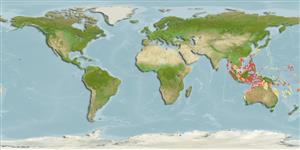>
Ovalentaria/misc (Various families in series Ovalentaria) >
Pseudochromidae (Dottybacks) > Pseudochrominae
Etymology: Pseudochromis: Greek, pseudes = false + Greek, chromis = a fish, perhaps a perch (Ref. 45335); andamanensis: Named for its type locality, Andamen Sea..
Environment: milieu / climate zone / depth range / distribution range
Écologie
marin récifal; profondeur 1 - 35 m (Ref. 81967). Tropical
Eastern Indian Ocean: eastern Andaman Sea, Indonesia and North West Shelf of Australia.
Taille / Poids / Âge
Maturity: Lm ? range ? - ? cm
Max length : 7.0 cm TL mâle / non sexé; (Ref. 48635)
Épines dorsales (Total) : 3; Rayons mous dorsaux (Total) : 22 - 25; Épines anales: 3; Rayons mous anaux: 13 - 15. This species distinguished by the following characters: 22-25 (usually 24) segmented dorsal-fin rays; 13-15 (usually 14) segmented anal fin rays; 16 circumpeduncular scales; second anal-fin spine much stouter than the third; a distinct bright yellow to orange stripe or series of spots along the base of the dorsal fin (when preserved pale grey to pale brown) (Ref. 81967).
Inhabits coral areas and is relatively common (Ref. 26137). Also found in coastal, lagoon and exposed seaward reefs (Ref 90102).
Life cycle and mating behavior
Maturities | Reproduction | Spawnings | Egg(s) | Fecundities | Larves
Lubbock, R., 1980. Five new basslets of the genus Pseudochromis (Teleostei: Pseudochromidae) from the Indo-Australian archipelago. Rev. Suisse Zool. 87(3):821-834. (Ref. 26137)
Statut dans la liste rouge de l'IUCN (Ref. 130435)
Menace pour l'homme
Harmless
Utilisations par l'homme
Outils
Articles particuliers
Télécharger en XML
Sources Internet
Estimates based on models
Preferred temperature (Ref.
123201): 26.7 - 29.3, mean 28.7 °C (based on 1953 cells).
Phylogenetic diversity index (Ref.
82804): PD
50 = 0.5000 [Uniqueness, from 0.5 = low to 2.0 = high].
Bayesian length-weight: a=0.00490 (0.00187 - 0.01281), b=3.11 (2.88 - 3.34), in cm total length, based on LWR estimates for this (Sub)family-body shape (Ref.
93245).
Niveau trophique (Ref.
69278): 3.4 ±0.5 se; based on size and trophs of closest relatives
Fishing Vulnerability (Ref.
59153): Low vulnerability (10 of 100).
